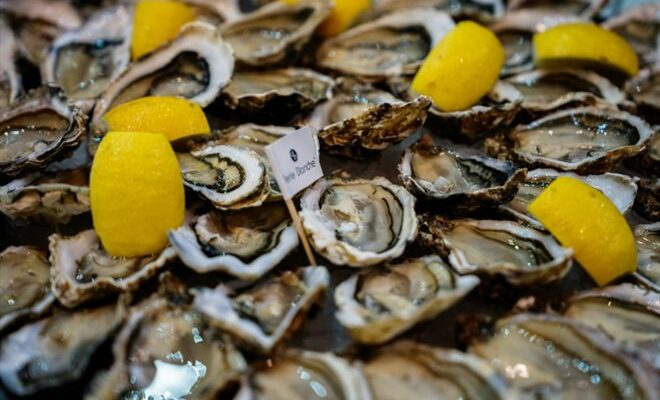For Christmas Eve, the stalls are full of fine foods but the purses are a little less full (AFP/Archives/Dimitar DILKOFF)
Stalls overflowing with fine delicacies, but purses a little less full: on the popular Place des Fêtes market in Paris, we prepare for Christmas Eve as usual, or almost.
The butcher-caterer stand of Florence Rocha, 60 years old, white cap screwed on her head, attracts the crowd. It must be said that you will find something to salivate there: veal ballotines with morel tails, scallop pies, verrines in various colors, parsley snails at 7.90 euros per dozen…
“For the holidays, we protect your wallet. On the other hand, we lighten it,” harangues one of the sellers. Here, it’s simple, “we have increased our prices by 10% for ten years, no more”, swears the boss. With interesting promotions – one free casserole for two purchased – “we make less margin, but we make up for it in quantity, there are always people at our place”.
Customers are price-conscious because inflation has been there. On average this year, the price increase would reach 5.7%, before falling to 2.5% in 2024, according to the harmonized consumer price index (HICP). Obviously, this affects the purchasing power of the French.
Laurent Bellanger, in his fifties, has been a trader in this market since 1990, where he sells throws and tablecloths in Christmas colors. He says he has seen the difference: “There are fewer customers, people go to the Belleville market which is cheaper. It’s not at all like before,” he judges.
– “Fewer orders”-
A few meters further on, hundreds of fish and shellfish stare – dully – at the passer-by who has ventured outside in this gloomy weather.
The Canadian lobster left its cold Atlantic waters, not without regret, for this foggy district of eastern Paris, where it now sells for around 50 euros per kilo. A lady barely looks at him: “How much are the knives? How many days can I keep them in the fridge?” she asks, not convinced.

For now, it’s the oysters that are stealing the show, while a buyer places orders for numbers 1 and numbers 3 (AFP/Archives/Dimitar DILKOFF)
For the moment, it is the oysters which steal the show, while a buyer places an order for numbers 1 and numbers 3. The fishmonger gets its supplies from Rungis, from the auction in Spain or from that of Boulogne-sur -sea. Demand is still there, despite inflation, says Mohamed Dahmani, one of the managers.
“People are still buying, but they are placing fewer orders. They prefer to come on site, with an idea of how much they are going to spend, to choose the products,” says the young man between two customers.
A few steps away, a queue formed around a cake stall. There we meet Alice Jacquemin, 33, a resident of the neighborhood, and her friend, who have come to pick up a brioche for Christmas. Bad luck, the one they were coveting just passed under their noses. “We got screwed,” they laugh. The couple also came to buy shellfish for their family Christmas. On the financial side, they say they don’t look at prices too much: “We should do it more!”
Same thing for Andrea Beyhaut, an elegant regular who leaves with two small pieces of log. “I’m quite addicted to this market,” she admits. Although she says she has clearly seen the effects of inflation, “there are still opportunities to find good prices here.”
Véronique des Rotours, another regular, is still hesitant. Oysters, salmon or capon? His New Year’s Eve list is not well defined. In any case, “it’s the best market in Paris, even people from the 1st arrondissement (in the upscale center of the capital, editor’s note) come here,” she says, before going to buy… honey.
© 2023 AFP
Did you like this article ? Share it with your friends using the buttons below.




